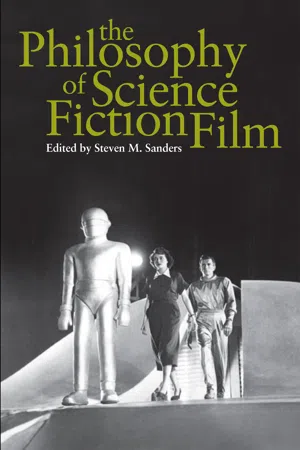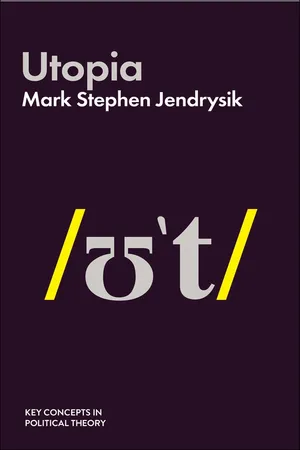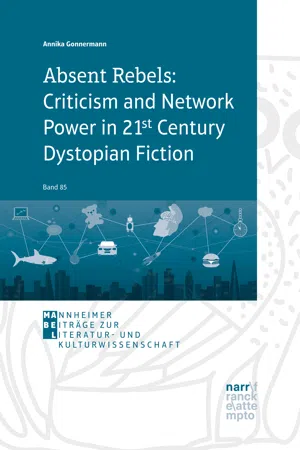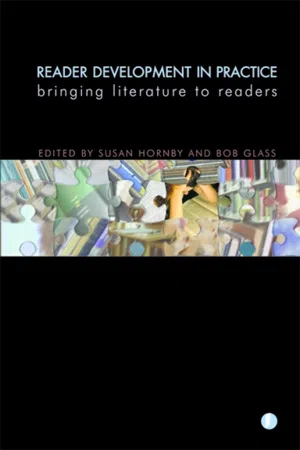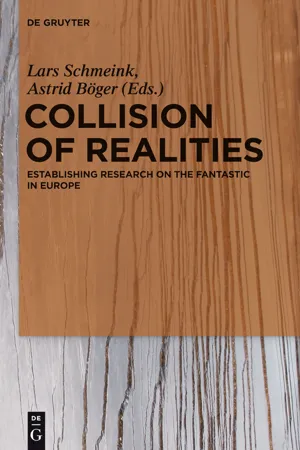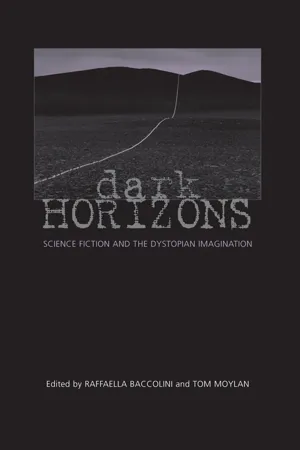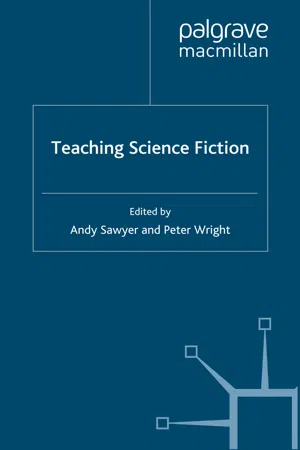Literature
Dystopian Fiction
Dystopian fiction is a genre that presents a society characterized by oppression, suffering, and often a totalitarian government. These narratives typically explore themes of control, surveillance, and the consequences of unchecked power. Dystopian fiction often serves as a cautionary tale, prompting readers to reflect on the potential consequences of societal and political choices.
Written by Perlego with AI-assistance
Related key terms
1 of 5
10 Key excerpts on "Dystopian Fiction"
- eBook - PDF
- Steven Sanders(Author)
- 2007(Publication Date)
- The University Press of Kentucky(Publisher)
1 R. Barton Palmer or worldview more generally. Having staged an unfamiliar reality, science fiction customarily provides it with depth through an anatomizing of its sustaining ideas and principles. Such exposition unfolds agonistically, as a contentious dialogue in the tradition of Menippean satire. Dystopian fic-tion, that is, science fiction that deals with a nightmarish future, particularly emphasizes this aspect of the Menippean form, offering, as Northrop Frye suggests, “a serious vision of society as a single intellectual pattern.” Such fiction, Frye observes, deals “less with people than with mental attitudes . . . with abstract ideas and theories.” 1 Dystopian Fiction, of course, is conventionally realist to the extent that such texts confect worlds recognizably like our own, to the extent at least that they are inhabited by human beings similar in essential ways to us. Yet these imagined settings are also marked by an often startling alterity, a “difference” that is the textual figuration of fear or desire or perhaps, more commonly, a complex mixture of the two. Dystopian Fiction presents us with futures that conform to our deepest terrors—and wishes. An important point is that we owe to the Enlightenment concept of progress, confirmed by much of the experience of the twentieth century, an acceptance of this kind of future. Enlightenment optimism about the inevitable malleability of nature and human nature provokes the expectation of a succession of states of affairs strikingly, substantially, and unpredictably distinct from the present. Such futures are not the products of some process defined by the glacial tempo of the longue durée, the kind of slow-moving historical change that led, for example, to the advent of capitalism. - New Atlantis (Kumar 1987: 99–100). But a specific form of dystopian thought and literature arose in the twentieth century. Dystopia “is largely the product of the terrors of the twentieth century. A hundred years of exploitation, repression, state violence, war, genocide, disease, famine, ecocide, depression, debt, and the steady depletion of humanity through the buying and selling of everyday life provided more than enough fertile ground for this fictive underside of the utopian imagination” (Moylan 2000: ix). Dystopia demands we examine our moral categories and judgments. Dystopian authors call our attention to the use and abuse of language for repressive proposes. They ask us to reconsider our assumptions about human nature and the limits of politics. Utopian thought needs dystopia. Dystopian thought warns against the dangers of utopian ideologies. Dystopia can be an “attempt to show, by as graphic and detailed a portrayal as possible, the horror of a society in which utopian aspirations have been fulfilled” (Kumar 1987: 109).Dystopias are projections of existing negative trends. Lyman Tower Sargent defined dystopia as “a non-existent society described in considerable detail and normally located in time and space that the author intended a contemporaneous reader to view as considerably worse that the society in which that reader lived” (1994: 9). Russell Jacoby said “dystopias seek to frighten by accentuating contemporary trends that threaten freedom” (2005: 13). Margaret Atwood describes dystopias as projections of current events carried to their logical extremes. In this way, “every dystopia is a history of the future” (Lepore 2017).Hope provides the essential focus of utopian thought. Fear provides the essential focus in dystopia. As Gregory Claeys says, “the central theme of the modern dystopia is despotism,” producing “the estrangement and isolation of individuals, and their fear of each other” (2017: 290). The true horror of dystopia lies in the loss of trust among human beings. In a dystopian state people cannot join together to challenge the conditions of their existence. Throughout the classic dystopian works the hero or heroine is isolated, unsure of the meaning and purpose of existence, left to their own devices in the face of overwhelming force directed against them. Individuals in dystopias are under constant surveillance by the state and its agents. Human freedom is redefined to mean subjection. If utopia is based on shared human experience, solidarity and fraternity, dystopia is based on atomization, isolation and disconnection. History is erased, altered and invented. Detached from their fellow human beings, dystopian subjects are also cut off from the stream of time, living in an endless now that provides no resources to imagine how things could be different. Dystopian thought presents an inverted picture of community. Instead of the total commitment demanded in utopia, alienation and a general lack of intimate connection (friendship, love) are the characteristics of dystopia. Civil society, understood as organizations and interpersonal relationships unmediated by the state, does not exist. The destruction of institutions and relationships outside of state control provides the key feature of dystopian oppression.
- Annika Gonnermann(Author)
- 2021(Publication Date)
- Narr Francke Attempto Verlag(Publisher)
Utopian writing – as an exercise in fictional sociology – then always has a clear connection to the present, although it is mostly set in the future (cf. Bauman, Freedom 89). 5 Formulating criticism, however, is only one of two functions dystopian narratives usually exhibit. When Han, Triplett, and Anthony argue “that some aspect of critique is at least implicit within all types of dystopian works” (“Introduction” 4), it is vital to remember that these books are never a neutral inquiry into the states of things, but actually burdened with normative standards circling around the question of the good life. It is therefore imperative “to recognise the partiality of theoretical and political positions” (Pinder 257) to be found in dystopian writing. Dystopias are always defined by their didactic warning function; 6 both Christine Lehnen and David Lorenzo even consider the warning effect a prescriptive feature of their genre definitions; dystopias are narratives that “serve as warnings regarding the future of contemporary society” (Lorenzo 6), and “can be seen as the epitome of literature in its role as social criticism” (Booker, Literature 3). They are the product of vigilant social analysts constructed as a warning, a “prophetic vehicle, the canary in a cage, for writers with an ethical and political concern” (Baccolini and Moylan, “Introduction” 2). Referring back to the “sociopolitical tendencies that could, if continued, turn our contemporary world into the iron cages portrayed in the realm of [e]utopia’s underside (ibid.), 7 Dystopian Fiction is always meant as a normative criticism of the socio-cultural and historical characteristics of the time of its own origins. Yet, while many critics take this circumstance for granted, no study has yet attempted to classify the use of criticism in Dystopian Fiction- eBook - PDF
Reader Development in Practice
Bringing Literature to Readers
- Susan Hornby, Bob Glass, Susan Hornby, Bob Glass(Authors)
- 2013(Publication Date)
- Facet Publishing(Publisher)
In this genre authors generally ‘extrapolate from contemporary western reality to envisage a future world whose dystopic features are terrible exaggerations of the social, political, ecological, technological and biological present’ in order to warn (Scutter, 1996, 4). The genre is, then, fundamentally underpinned by the authorial premise that young people today need to know about the dire consequences of human behaviours, rather than be sheltered in a protective enclave of ignor-ance and innocent idealism. As Johnny Online in Thorpe’s Hybrids puts it: Don’t you realise what you’re up against? You seem to think this is like some comic book adventure and you’re superheroes. Instead, it’s just a bunch of sad, scared and dangerous people running around and smashing into each other, causing damage cos they didn’t think through the consequences of what they were doing. (Thorpe, 2007, 245) Admonitory literature is typically regarded as having a dual purpose. I write with the firm conviction that futuristic pessimism is not designed to depress or dispirit its young readers. Like all warning literature, I believe it is underpinned by the clear impulse to make people good by choice. Futuristic books are, as Harrison (1987, 86) says of Huxley and Orwell’s Dystopian Fiction, ‘calls of the imagination to the ethical’. They use their pessimistic frame of reference to assert that, for the reader, it is not too late. 124 Section 3 Works of imagination Even though some writers may, at heart, seriously doubt humanity’s ability to change, they frequently hope to suggest the possibility of something better in moral terms for their young readers. Some common dystopian themes and preoccupations Like in the classic adult dystopias, the centrepieces of many of the children’s futuristic novels that began to emerge in the 1970s were political or technological. - eBook - PDF
Collision of Realities
Establishing Research on the Fantastic in Europe
- Lars Schmeink, Astrid Böger(Authors)
- 2012(Publication Date)
- De Gruyter(Publisher)
In very specific ways, dystopian – particularly post-apocalyptic – narratives do indeed demonstrate our ability to imagine, visualize and describe, perhaps more impressively than other forms of SF, an empirically and realistically plausible future world. In connection with this viewpoint, in a recent article on Atwood’s latest novel The Year of the Flood written for the London Review of Books , Fre-dric Jameson himself has revised his previous assumption to encompass the evident link between the post-apocalyptic science fictional world and actual-ity in the very perspective of a predictable future. He therefore observes that at this moment of time, all fiction approaches science fiction, as the future, the various futures, begin to dissolve into ever more porous actuality: and the end of the world seems to approach more rapidly than the unified world market itself. (n. pag.) On this point, in her review of Oryx and Crake , significantly entitled “Bio-perversity”, Lorrie Moore has commented on the main features of dystopi-an fiction, observing that, from her viewpoint a dystopian novel is not intended as a literal forecast, or even necessarily as a log-ical extension of our current world. It is simply, and not so simply, a bad dream of our present time, an exquisitely designed horror show in which things are changed from what we do know to a dream version of what we don’t. (n.pag.) Nevertheless, whether it depicts a bad dream or does not, the narrative in Oryx and Crake is undoubtedly deeply focused on the (predictable, plausible and possible) dangers of genetic engineering and mirrors its author’s evi-dent concern for this specific issue. - eBook - ePub
Dark Horizons
Science Fiction and the Dystopian Imagination
- Tom Moylan, Raffaella Baccolini, Tom Moylan, Raffaella Baccolini(Authors)
- 2013(Publication Date)
- Routledge(Publisher)
Traditionally a bleak, depressing genre with little space for hope within the story, dystopias maintain utopian hope outside their pages, if at all; for it is only if we consider dystopia as a warning that we as readers can hope to escape its pessimistic future. This option is not granted to the protagonists of Nineteen Eighty-Four or Brave New World. Winston Smith, Julia, John the Savage, and Lenina are all crushed by the authoritarian society; there is no learning, no escape for them. Conversely, the new critical dystopias allow both readers and protagonists to hope by resisting closure: the ambiguous, open endings of these novels maintain the utopian impulse within the work. In fact, by rejecting the traditional subjugation of the individual at the end of the novel, the critical dystopia opens a space of contestation and opposition for those collective “ex-centric” subjects whose class, gender, race, sexuality, and other positions are not empowered by hegemonic rule. Another device that opens up these texts is an intensification of the practice of genre blurring. By self-reflexively borrowing specific conventions from other genres, critical dystopias more often blur the received boundaries of the dystopian form and thereby expand its creative potential for critical expression. Drawing on the feminist criticism of universalist assumptions—fixity and singularity, and neutral and objective knowledge— and recognizing the importance of difference, multiplicity, and complexity, of partial and situated knowledges, as well as of hybridity and fluidity, the critical dystopias resist genre purity in favor of an impure or hybrid text that renovates dystopian sf by making it formally and politically oppositional. In Kindred, for example, Butler revises the conventions of the time travel story and creates a novel that is both sf and slave narrative, while her Parable of the Sower combines survivalist sf with the diary and the slave narrative - eBook - PDF
- A. Sawyer, P. Wright, A. Sawyer, P. Wright(Authors)
- 2011(Publication Date)
- Palgrave Macmillan(Publisher)
60 Teaching Science Fiction intervention in an ongoing debate. To read any given work outside the context of that debate, or with only passing reference to it, is to miss much of what makes it distinctive – not to mention the ways in which the reading of each work modifies the reading of all. By way of illustration, let us consider in more detail the case of two works which frequently feature in courses on both utopian litera- ture and science fiction: Huxley’s Brave New World and Le Guin’s The Dispossessed. Taught as science fiction, their relation to the utopian tradition cannot be ignored; nevertheless, it may be argued that those aspects of the text that such a context highlights are likely to produce rather different readings than emerge from their consideration as utopian literature per se. The relationship of Brave New World to the utopian tradition is, of course, antagonistic. Described by David Sisk as ‘the seminal dystopia of the twentieth century’, 17 it is also often referred to as an anti-utopia, posing the question of whether there is any useful distinction to be made between the terms. While they are often treated as synonymous, more recently attempts have been made to distinguish between them – although it is fair to say that general agreement has yet to be reached on what the difference actually is. 18 For some, ‘dystopia’ constitutes specifically the parodic inversion of utopia (into which category Brave New World clearly fits) – a representation of where the utopian impulse would really lead – whereas others use the term to refer more broadly to any depiction of an undesirable society, regardless of its provenance, reserving ‘anti-utopia’ for those depictions that are actively hostile to utopianism. Jameson, indeed, goes so far as to argue that utopia and dystopia are ‘not opposites and in reality have nothing to do with each other’. 19 A dystopia, in other words, need not necessarily exclude the possibility of utopian alternatives. - eBook - PDF
Meals to Come
A History of the Future of Food
- Dr. Warren Belasco(Author)
- 2006(Publication Date)
- University of California Press(Publisher)
F I V E DYSTOPIAS A vibrant forum for discussion of social and scientific hubris, the dystopian story dates at least as far back as Mary Shelley’s Frankenstein (1818). Utopia’s evil twin, the dystopian story starts with the same spec-ulative question: Can we invent a better, indeed a perfect, world? But the answers are quite different, mainly because dystopian writers refuse to accept the big “if” that is the central utopian caveat: what if people were wise enough to use cornucopian technologies for democratic, egalitar-ian purposes? Dystopias distrust such convergences between mechani-cal and social engineering, for the law of unintended consequences dic-tates that gee-whiz technologies do not always produce happy social results. Concerns about a modernist blowback began to mount in the twen-tieth century. While some Victorians had expressed their doubts about the direction modern civilization was taking, their works tended to be either hysterically apocalyptic (e.g., Richard Jeffries’s After London ) or utterly romantic (William Morris’s News from Nowhere ). More com-plex second thoughts began to be voiced at the turn of century, particu-larly from British author H. G. Wells, whose love of science and inven-tion was restrained by a keen awareness of political and natural limits. A cornucopian with strongly socialistic as well as Malthusian tendencies, Wells produced works of remarkable subtlety and ambivalence—and in virtually every genre, from sober white papers to far-fetched fantasy fiction. No wonder he is considered one of the founders of professional 1 1 9 futurism. 1 Four of his early novels in particular anticipated the darker mood to come: The Time Machine (1895), The War of the Worlds (1898), When the Sleeper Awakes (1899), and The Food of the Gods (1904). - eBook - PDF
- Brian Baker(Author)
- 2017(Publication Date)
- Red Globe Press(Publisher)
Moylan periodises the emergence of this form to the late 1980s and early 1990s, as a response to specific historical, social and cultural conditions, as well, as we have just seen, to the rise of Cyberpunk SF within the genre itself. In his conceptualisation of ‘dystopia’, Moylan differentiates it from both ‘utopia’ and ‘anti-utopia’, in ways similar to Sargent’s taxonomy given earlier in the chapter. For Moylan, The dystopian genre has always worked along a contested continuum between utopian and anti-utopian positions: between texts that are eman- cipator, militant, open, and ‘critical’ and those that are compensatory, resigned, and quite ‘anti-critical’. That the recent dystopias are strongly, and more self-reflexively, ‘critical’ does not suggest the appearance of an entirely new generic form but rather a significant retrieval and refunction- ing of the most progressive possibilities inherent in dystopian narrative. (Moylan, 2000, p. 188) The assessment of dystopia as a form which is already potentially crit- ical and self-reflexive echoes the conceptualisation of utopia in Gary Saul Morson’s The Boundaries of Genre (1981), in which he proposes that utopia is a form on the ‘boundaries’ of fiction and tends to incorporate other genres, such as the romance and the pastoral. Because of this, Morson argues, utopias are particularly susceptible to parody, because of utopia’s own boundary-status and because the genres it imports are themselves susceptible to parody. The relation between ‘utopia’ and ‘anti-utopia’ is itself coded as parody, Morson suggests: There exist two classes of texts that enter into dialogical relation with utopias, namely anti-utopias, which parody utopias, and meta-utopias, in which utopia and anti-utopia themselves enter into an ultimately inconclu- sive dialogue. - eBook - PDF
Playing Dystopia
Nightmarish Worlds in Video Games and the Player's Aesthetic Response
- Gerald Farca(Author)
- 2018(Publication Date)
- transcript Verlag(Publisher)
Even though Jameson’s observations focus on the genre of utopia, it is feasible that his insights hold true for dystopia as well—which brings the investigation back to the question of the vision’s totality. In this respect, Kumar pointed out that, similar to utopia, dystopia has fragmented and narrowed its focus. Unlike Orwell or Huxley, who managed to compose an alternative society that centred on “a dominant trend or central principle in contemporary developments,” recent dystopias “have had highly spe-cific targets” and have generally failed to shock their readers “with a compelling sense of a march into a nightmarish future.” 58 Kumar underlines this claim in a recent article where he maintains that “it was never the function of dystopia to give a complete picture of the world” but “to pick out the most distinctive and novel features of the time and to present them in the form of an imaginatively realised society.” 59 Sometimes, however, specific trends have far-reaching ef-fects—as with Huxley, who chose to attack consumerism in Brave New World , thereby touching a nerve that continues to resonate in the 21 st century. 60 These observations notwithstanding, the question remains whether dystopia’s picture is partial—focusing on specific issues—or whether it manages to capture a dominant trend that plagues social totality. The VGD, for the most part, contin-ues the trend of specific targeting, as it issues focused warnings that communicate 56 Ibid., 14. This facet connects the genres of utopia and dystopia to the procedural repre-sentations of simulation , which is generally understood as a simplification of empirical reality (see chapter V). In the words of Salen and Zimmerman: “simulation cannot de-pict every aspect of something; it has to choose a very small subset of characteristics around which to build its representation.” (Salen Katie and Eric Zimmerman, Rules of Play: Game Design Fundamentals [Cambridge, Mass.: MIT Press, 2004], 423).
Index pages curate the most relevant extracts from our library of academic textbooks. They’ve been created using an in-house natural language model (NLM), each adding context and meaning to key research topics.
